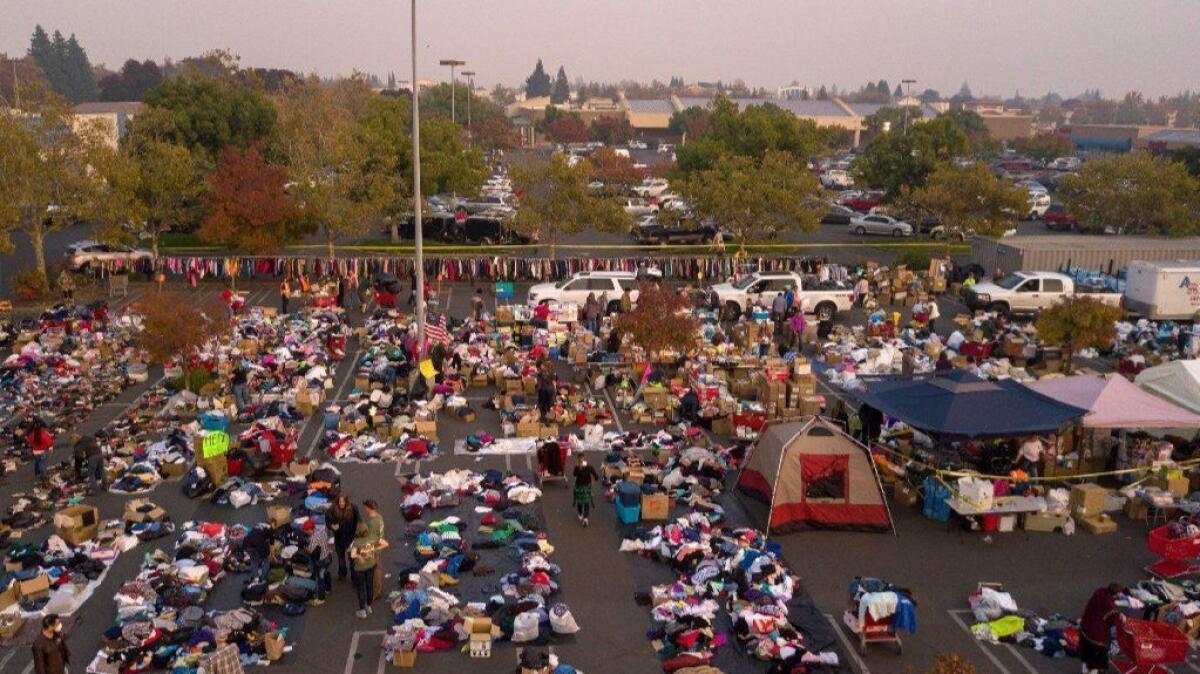Inundated with Camp fire survivors, Chico is a âcity within a cityâ

Reporting from Chico, Calif. â Everywhere Chris Persson goes, people are still talking about the Camp fire.
While shopping for groceries, the Chico resident was told the store had hired fire survivors from Paradise. At lunch, she overheard a fire evacuee say she was given a free tank of gas to run errands.
For the record:
8:25 a.m. Dec. 21, 2018An earlier version of this article gave the name of the Chico police chief as Mark OâBrien. His name is Mike OâBrien.
âYou canât go anywhere without meeting somebody with a story,â said Persson, who has lived in Chico since 1988.
In the wake of the Camp fire, which ignited more than a month ago, residents of Chico say they are settling into a ânew normalâ â increased traffic, homes crowded with multiple families and a fleet of so-called fifth wheel travel trailers parked in driveways and RV parks.
Because of its size and proximity to communities destroyed by the fire, Chico was the logical place for many displaced fire survivors to relocate. Now, however, the city is struggling to balance recovery efforts with maintaining the quality of life that first drew residents to the city of 93,000.
In some cases, tensions have boiled over in public hearings.
âItâs a balancing act,â said Mark Orme, Chico city manager. He estimated that the city had seen anywhere from a 10% to 20% population increase â a number officials didnât plan to hit until 2030.
âIâm running a city within a city. Iâve got two cities that Iâm managing right now,â Orme said. âThatâs something Iâve never read about in all my studies.â
Last week, residents filled the City Council chambers to hear officials talk about a Federal Emergency Management Agency proposal to place 250 trailers on a grassy, 80-acre vacant lot off Eaton Road, in the north end of town.
âI would have bought a house next to a trailer park if I wanted that,â one man said to council members. Another man said his son and wife had lost their home, but he too was concerned about the location of the proposed trailers.
That same night, state officials presented a plan to open a debris-sorting facility in the south end of town to accommodate the estimated 15 million tons of debris from the fire.
Some residents expressed their worries about the environmental impact of locating a debris facility so close to homes, as well as increased traffic from trucks hauling metal and concrete from the burn area.
âYouâre treating us as collateral damage,â said Debbie Villasenor, who is a member of the Barber Neighborhood Assn., a group that represents the neighborhood in the south end of Chico where the debris site was proposed.
âYou need to look at us,â she said. âWe are people, we are not a site.â
At the end of the meeting, officials needed to be escorted to their vehicles. A week later, FEMA and California Office of Emergency Services officials said that both proposals had been abandoned, partly because of the local outcry.
âWeâre completely supportive of our neighbors, and we want them housed yesterday,â said Persson, who lives near the proposed trailer site and attended the meeting. âItâs really about safety.â
Perssonâs own family has been affected by the Camp fire, which killed 86 people and destroyed nearly 14,000 homes. The brother of her longtime partner narrowly escaped in his truck with two people and three dogs. His home burned down, and heâs waiting to move to a new apartment.
Villasenor, first drawn to Chico 34 years ago because of the green space and small-town charm, said itâs important to make smart plans for the fire recovery because itâs not just a matter of months, but years. âEverybody wants to help in that effort,â she said. âTogether weâll make that happen.â
Since the Camp fire, traffic in Chico has increased by 70% and vehicle accidents have increased by 29%, according to city officials and police. Calls for service to the Police Department also have increased, officials said.
Last weekend was a busy one for law enforcement. Although calls are usually concentrated near downtown, where the Cal State Chico campus is located, police were receiving calls from all over the city.
âWeâre a police department that wasnât designed to police an additional 10,000 to 20,000 people, but that has been the reality,â said Mike OâBrien, the Chico police chief. OâBrien said his officers had been helping out with the disaster from the beginning, and some lost their homes.
âWe are now tasked with keeping these folks safe,â he said, âand making sure theyâre not traumatized twice.â
Chico is the largest city in a county that was experiencing a housing shortage and a homeless crisis even before the fire. Laura Cootsona, the executive director of the Jesus Center, a 23-bed homeless shelter in Chico, said she feared the homeless population would more than double.
Any less than that and âweâd be getting off easy,â she said.
On a daily basis, Cootsona hears stories about people living with relatives or friends. An employee of hers has taken in 15 animals. Her church has absorbed another congregation.
âIt feels like people canât really get any breath away from it,â she said. âAnd weâre only six weeks into it.â
Hotels are still full. And as of Wednesday, there were just 13 rentals available in the city, said Chico Mayor Randall Stone.
Stone fears that Paradise and other fire-devastated communities might not be repopulated, which could deplete sales and property taxes in Chico.
Stone recalled visiting another town that had been affected by wildfires in recent years. One of the cityâs officials became emotional in front of him and asked, âHow do you avoid becoming a community of fifth wheels?â
More to Read
Sign up for Essential California
The most important California stories and recommendations in your inbox every morning.
You may occasionally receive promotional content from the Los Angeles Times.










